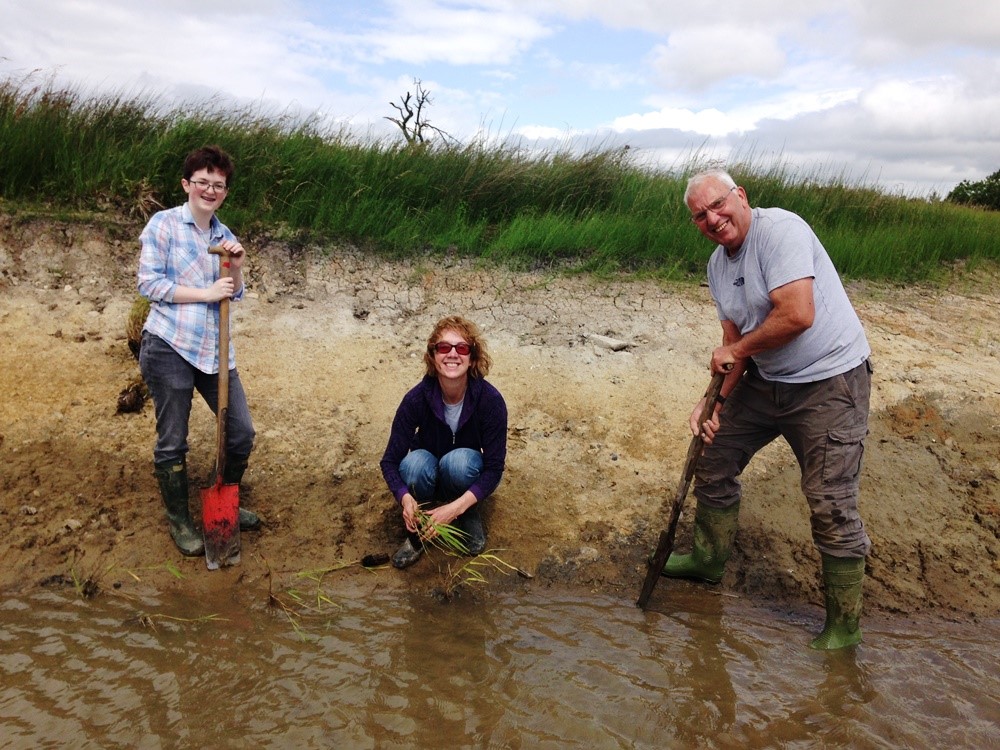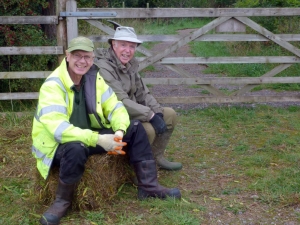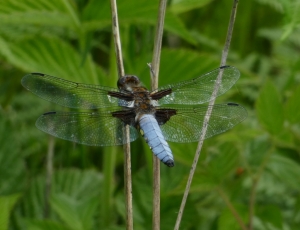Blog Archive (24) Posts Made in October 2012
Flower Walk
Wednesday, October 31st 2012
Every month during the year, volunteers with an interest in botany take a walk around the reserve recording every species of flower that is seen. During the summer this can be a very long job with over 100 species recorded. During the late autumn and winter this is a much quicker job, though there are still a surprising number of flowers about.
Today, 28 species were recorded including Self Heal and Heather.
These walks provide us with a fantastic record of what is to be found on the reserve, thank you to everyone who is involved during the year.
Happy Halloween!
Wednesday, October 31st 2012
The Army Welfare Service hosted their annual Halloween walk and party at Foxglove this evening. Over 75 people attended this event, all connected to the garrison in some way. To entertain the children there were spooky tales at the outdoor classroom, craft activities and hot dogs at the Field Centre. The walk around the reserve was obviously scary as screaming children could be heard all around the red route!
Feeder Frenzy!
Tuesday, October 30th 2012
Sixteen volunteers came to help us with several tasks at Foxglove today. Birch and willow were cut back along part of the access track to improve visibility driving up into the reserve. The Leyburn branch of the Dry Stone Walling Association will be here on Saturday to start building the feature wall and seats out side the Field Centre. Volunteers cut back overhanging willow and dug a foundation trench so that they are able to start construction this weekend.
Cleaning the feeders is required every 5-6 months and is a favourite job of our volunteers. All the seed feeders were collected from net rides and taken to the portacabin where they were taken apart and thoroughly scrubbed before being put back together…with only two screws spare at the end!
They are now drying before being put back out later in the week. Thank you to everyone who has lent a hand helping us here today!
Aysgarth School Visit
Monday, October 29th 2012
Children from class PP2 at Aysgarth School visited Foxglove to have a look at the reserve during the Autumn. They were taken on a nature walk in the morning, ending in an natural art activity, creating pictures from whatever was found on the plantation floor.
This owl picture was inspired by the owl box hanging on a nearby tree.
The afternoon was spent learning about camouflage, other ways that prey avoids predators, before finishing off with a play in the dams.
Fungi
Sunday, October 28th 2012
Fungi can be found throughout the year, but autumn is probably the best time. They come in all shapes, sizes and colours but one thing they all have in common is that they need organic material to live on. If the organic material is alive then the fungus is a parasite, for example the white fungus that can be found on fish kept in ponds and fish tanks. Fungi growing on dead wood and similar material are saprophytes.
This fungus is a species of puff ball, it turns brown as it ripens. The spores are released through an opening on the surface.
.jpg)
Log piles provide an ideal habitat for fungi.
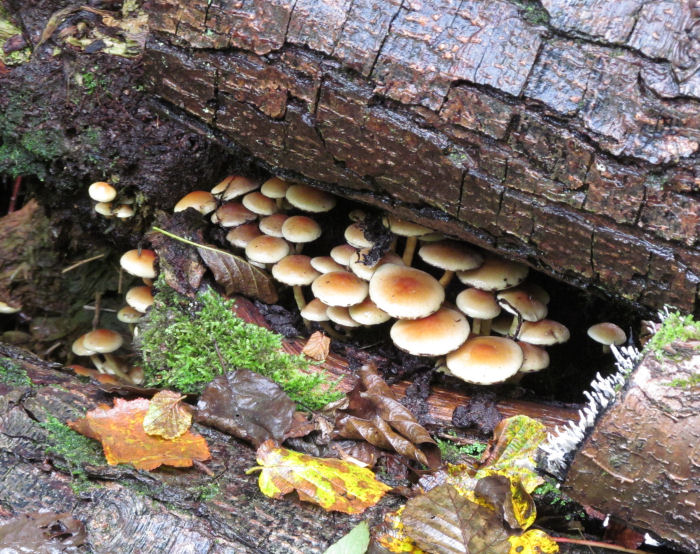
A clump of fungi growing together, looking not too spectacular…
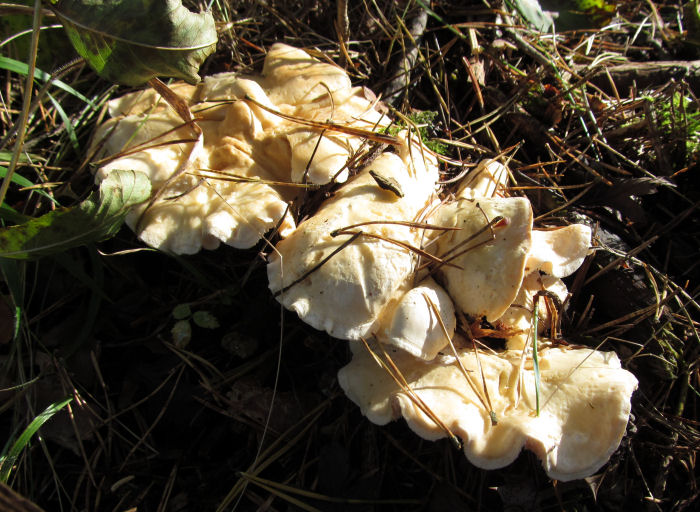
until viewed from underneath. It looks like the spines of a hedgehog, hence its name Wood Hedgehog.
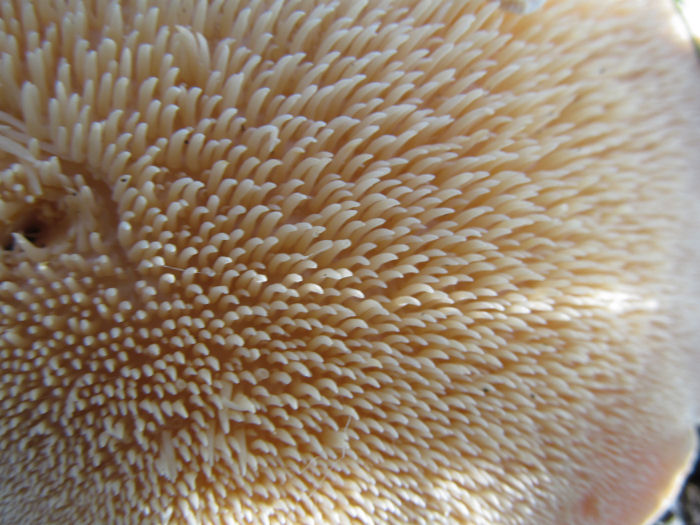
Bonfire Cookery
Sunday, October 28th 2012
Adam, Sue and Elizabeth prepared the food. Everything excepting the kitchen sink, was packed into bags and carried to the woodland. Brian and Elizabeth set off with everyone to take the long route to the bonfire.
Crossing the first bridge Otter spraint was spotted on a stone. We have been looking for a new stone that the Otter would use as the regular one was washed away in the floods.
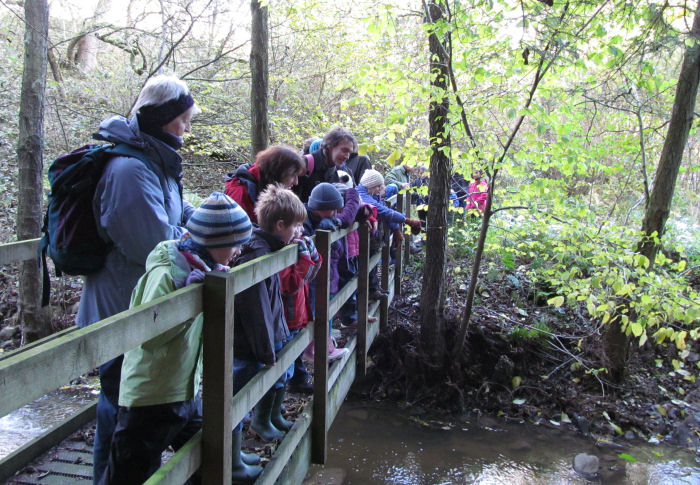
Many fungi were observed and the 'fairy ring' of Clouded Funnel was paced out at 36 strides - we will see how big it is next year.
When we reached the bonfire the potatoes were already cooking but the chidren added apples, sultanas, and bananas with chocolate to the fire - the fruit was wrapped in tin foil! Adam demonstrated how to fix the twister dough to the willow branches. Soon everyone was busy cooking!
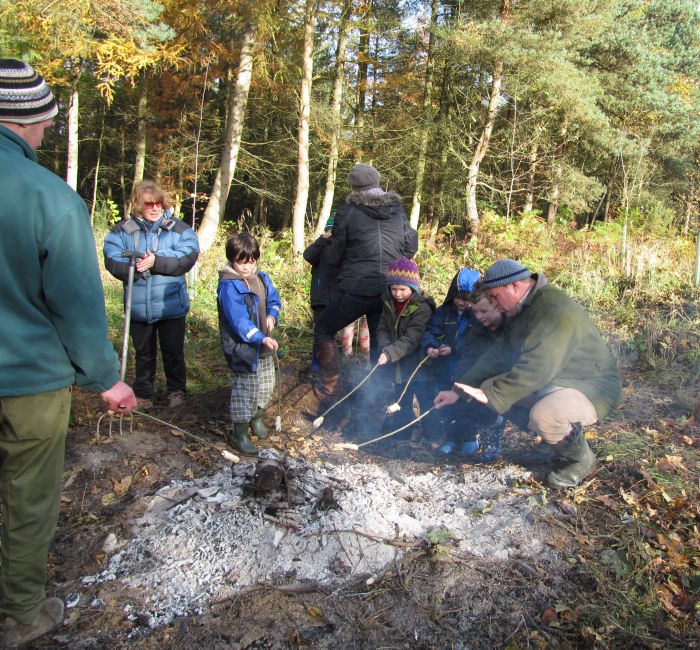
When the dough is cooked it easily comes off the willow. Sandra was on hand to add the honey to the twister dough. By now the bananas were ready and the apples were not far behind.
.jpg)
Sue cooked the Bannocks to perfection!! These must not be cut with a knife, only pulled apart.
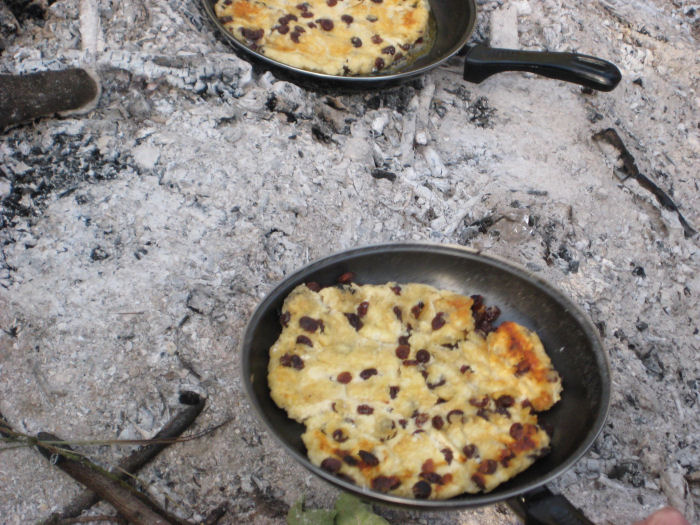
After all this food, it was decided that the baked potatoes were ready! A back to front meal!
Before we left the bonfire a group photograph was taken to the call of 'Baked Potato'.
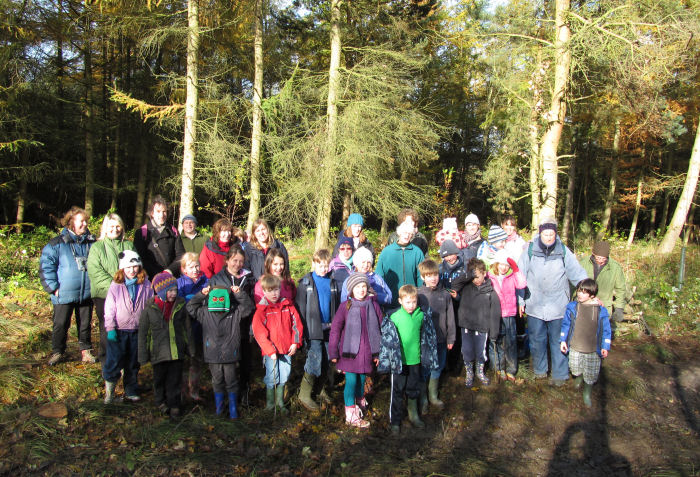
A unanimous decision was made by the children to return to the Field Centre via the tank track.
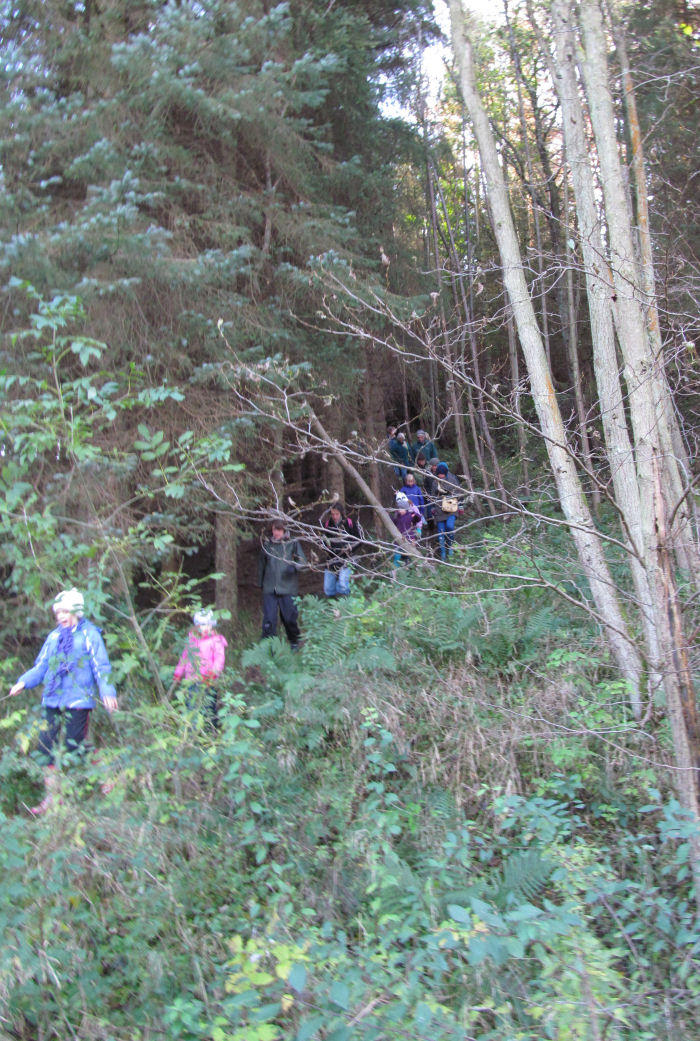
Everyone enjoyed the cooked food and there were many thanks to the chefs. There were also requests for a repeat performance next year.
Building a Bonfire
Thursday, October 25th 2012
Work continued up in the woodland this morning, clearing more of the diseased Sycamore, ready for replanting with a mix of native trees later in the winter. The bonfire was roaring by lunchtime and should still be hot enough for the last Eco Club of this year, when the children will be learning to cook on an open fire
Autumn Moths
Wednesday, October 24th 2012
Thirty moths of nine species were waiting patiently in the moth trap for Elizabeth first thing this morning. Amongst these were several December Moths. These fly between early October and January and are seldom seen.
The most striking species in today's catch was Angle Shades. These fly all year round but their numbers swell between August and October when they are joined by immigrants.
From the front this one looks quite startled and shares a resemblence with Gonzo from the muppet show!
Finally, Feathered Thorn is the latest of the thorn moths to fly. The larvae of this species feeds on a wide range of broadleaved trees including, Willow, Hazel, Dog Rose, Hawthorn and Blackthorn and has also been reported on Larch. All of these trees are abundant at Foxglove.
Autumn is going to be a busy time for the Foxglove team. During half term there are lots of fun activity sheets to take out on an Autumn walk. These are available from the Field Centre in return for a small donation and are a great way to get the whole family out in the fresh air.
The next winter worky day is on Saturday 3rd November. This will be a a special occasion as in addition to the main habitat work, members of the Dry Stone Walling Association will be constructing a curved seat to celebrate the 20th anniversary of the reserve. See the events section for further details. Booking essential.
There will be a coffee morning in Richmond Town Hall on Thursday November 8th. We are collecting empty jam jars, sweets and ribbons to make a 'sweet tombola'. If you would like to donate any of these items please leave them in the kitchen. Please get in touch if you can offer any help with baking cakes beforehand or assisting on the day with tea making, serving and washing up.
Woodland Work
Tuesday, October 23rd 2012
The list of winter jobs on the reserve is always a long one and this year is no exception. Up at the top of the woodland is an area of Sycamore trees that have become diseased and need to be removed. The sweet sap of these trees is irresistible to squirrels who have damaged the trees in their search for a sugar rush!
Around twenty trees were felled by chainsaw and then tidied away by volunteers. A large habitat pile of logs now lies by the pathside.
By the end of the day, this section of the woodland trail was looking very different. Over the winter months it is hoped that more trees will be planted here to fill in the gaps.
Thank you to everyone for your hard work today.
Special Birds
Monday, October 22nd 2012
A beautiful morning greeted the bird ringers as they arrived first thing this morning. Scots Pines along the middle moor fence were bathed in early morning sunshine.
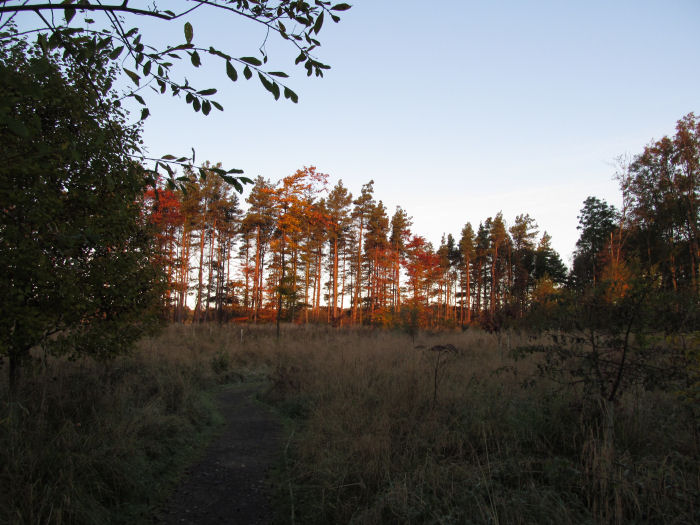
Willow Tits are not often found on the reserve and so there was a great deal of interest in this one.

A Kingfisher was caught over the weir and returned to the ringing room - was this the bird visitors have seen fishing in the lake over the last few days? Tony explained how to age the Kingfisher before Joanna put a ring on it.

In the sunshine the beautiful irridescent colours could be seen on this young male.

By the end of the day 214 birds of 21 species had been processed including more Brambling, Bullfinch, Siskin, Lesser Redpoll, Goldcrest, Reed Bunting, Goldfinch, and Wren. Among the retraps were several birds between five and seven years old.
Thank you to everyone who helped today.
Calm Reflections
Friday, October 19th 2012
The sycamore avenue had the final strim of the year, the path had become very overgrown and considerably narrower. It is now all neat and back to the proper width. As it was being cut Elizabeth walked through taking some pictures of the rapidly changing autumn colours.
The lake was looking spectacular in the still conditions, and a Little Grebe was spotted here diving for food at lunch time.
Route Planning
Thursday, October 18th 2012
Waterproofs and wellies were needed even though the heavy rain had stopped, as Brian, John and Elizabeth set out to plan the route for the fungus foray on Saturday.
The route was alongside a flooded Risedale Beck.
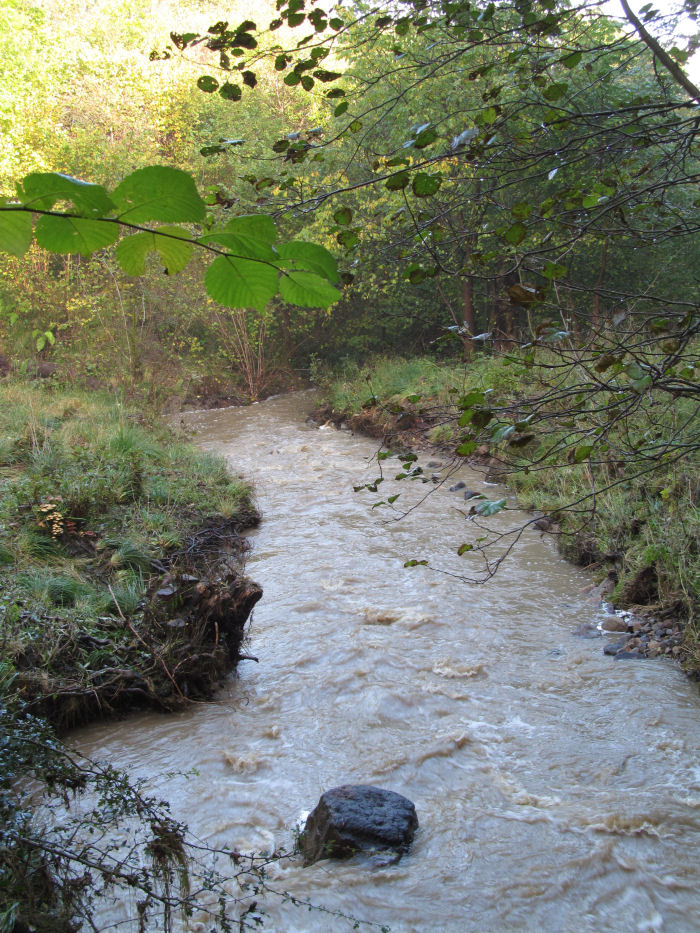
And into the area cleared by volunteers earlier in the year, where a hint of autumn colour could be seen.
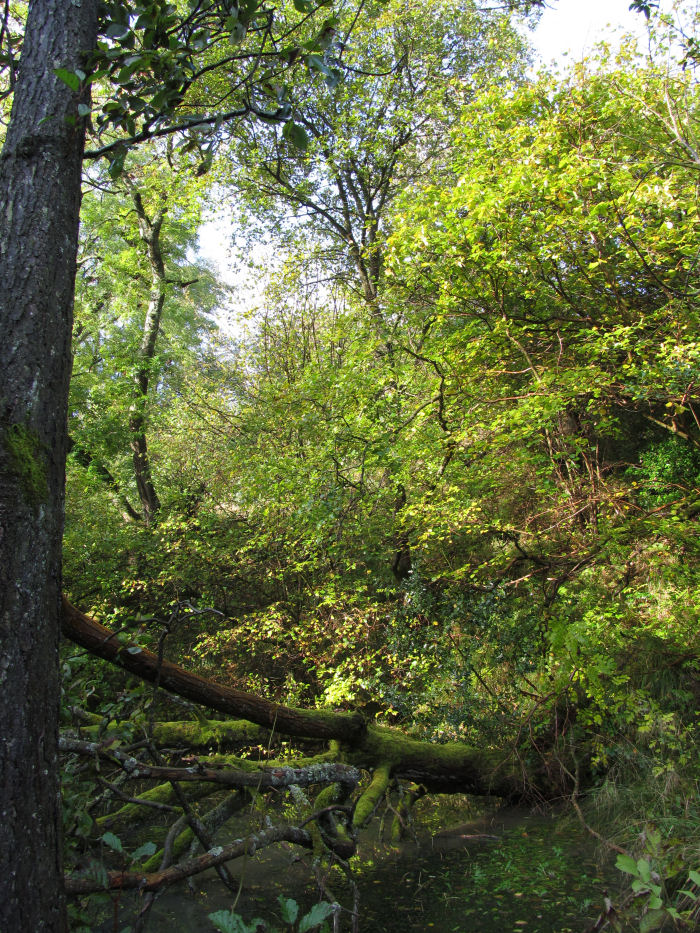
Continuing along the path the sun's rays streamed through the conifer trees.
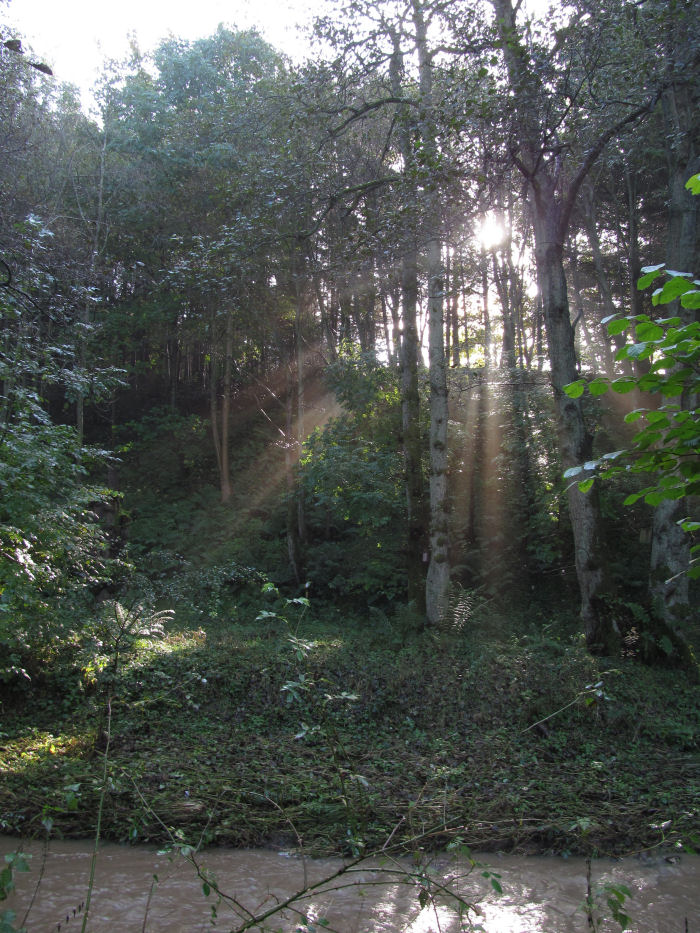
There has not been the usual amount of fungi through the autumn so far. The fruiting bodies have either been good food for slugs and snails or have died back very quickly. However the walk revealed many fungi of different types and much of it was in pristine condition. The rain added to their beauty by filling the cup shaped ones with water.
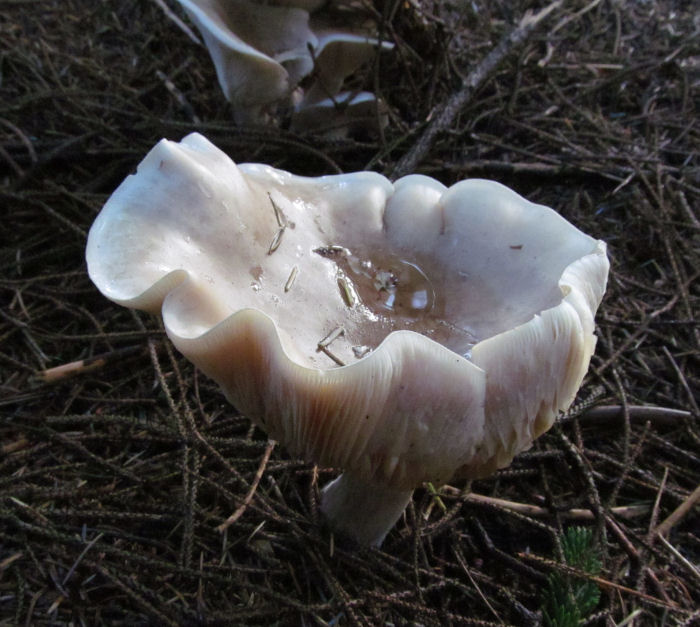
These strange looking 'grass' shoots are actually fungi! We think they are Slender Club (Macrotyphula juncea).
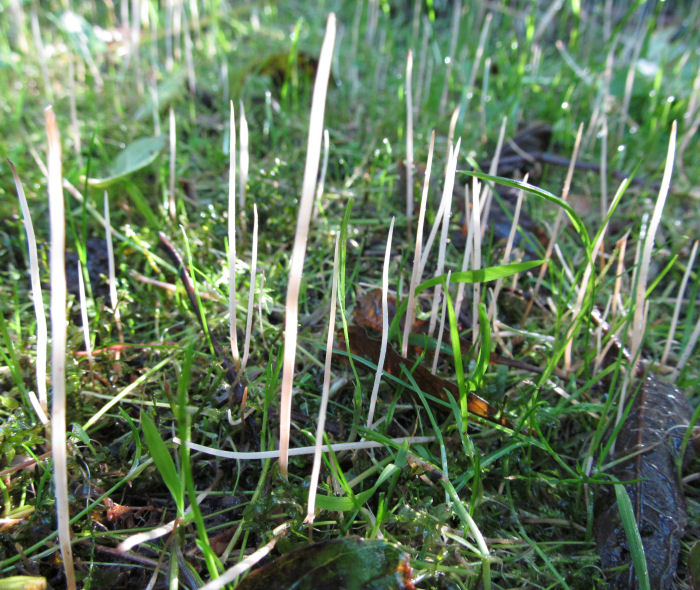
Stone, Scrub and Several Showers
Tuesday, October 16th 2012
A curved stone wall with seating has been planned for the picnic area opposite the Field Centre in conjunction with the Leyburn branch of the Dry Stone Walling Association. Volunteers from this group will be building the wall over the first weekend in November. About 20 tonnes of stone will be needed for the project and the first delivery arrived today.
Volunteers were thankfully on hand to help unload the trailer! Work was also started along the access road clearing out the dense overgrown scrub layer.
While working Brian found this Candle Snuff fungus on an old Birch stump. This fungus gets its name as it is black at the base, grey in the middle and white at the tips - much like a snuffed candle wick.
A Surprise!
Monday, October 15th 2012
The morning was still and calm as can be seen in this photograph of the lake. At 0730 in quite frosty conditions the bird ringers began putting up the nets.
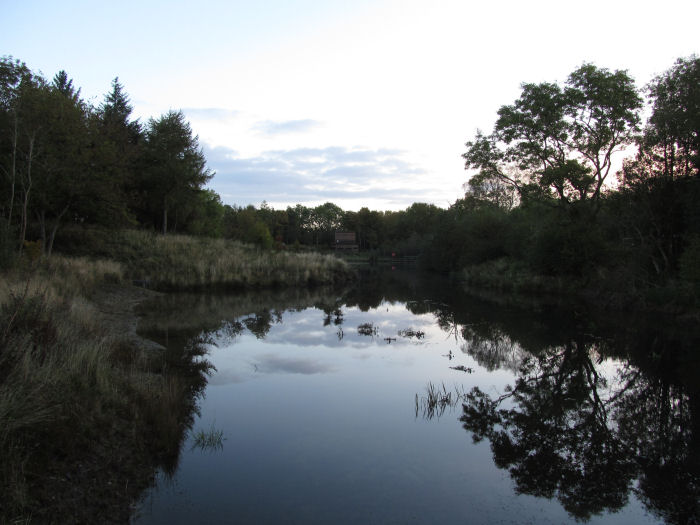
Ringing takes place throughout the year and 20 years of ringing and CES were celebrated with a cake. Decorations included Foxgloves, birds, an owl and not forgetting the Radio!!

The data set collected over those 20 years is amazing and provides details of longevity, survivability, site fidelity and productivity. Thank you to everyone who has contributed to this data over that time - from the bird ringers themselves to the volunteers who maintain net rides, make tea, and tidy up at the end of each session.
During the day a number of interesting species including Goldcrest, several Treecreeper, Goldfinch, Siskin, Lesser Redpoll and Reed Bunting were amongst the birds handled. Surprisingly there were 10 new juvenile and adult Bramblings ringed today. These birds usually visit Foxglove at the turn of the year.
The retraps included a Chaffinch that was at least 7 years old and a Great Tit that was 8 years old.
Removing a bird from the bird bag is always a surprise, but today for the first time in 20 years the small brown bird taken out was the first Tree Sparrow to be caught and ringed on the reserve. 183 birds were processed altogether of 21 different species.
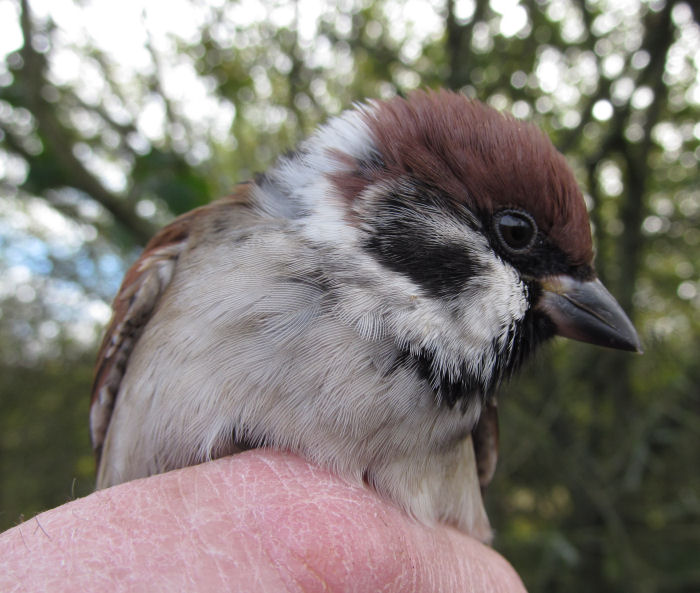
As always with unusual birds, the names of ringers who have not ringed the species are put into a draw. Liz's name was drawn and so her initials are recorded against the details of this bird.
Thank you to everyone who helped today.
Autumn
Saturday, October 13th 2012
The larch tree is the only deciduous conifer on the reserve. At this time of year the green needles begin to change colour to yellow and begin to fall.
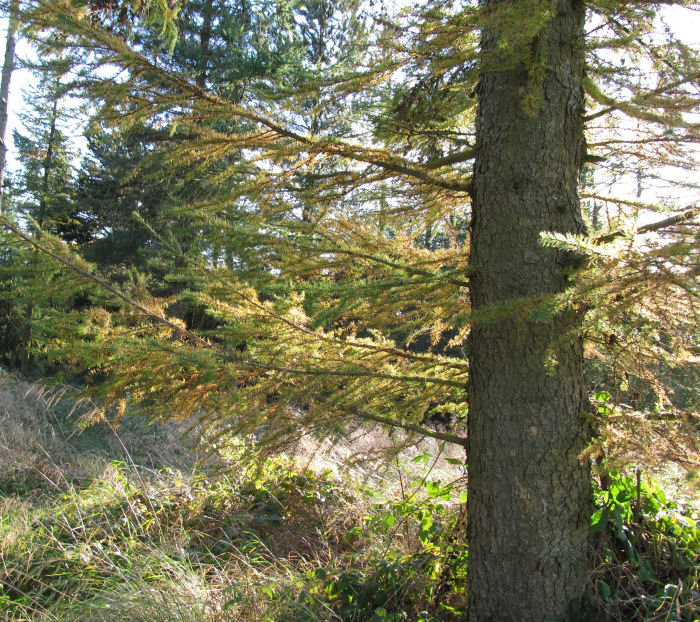
Soon the paths through the Sycamore Avenue and woodland will turn golden brown with larch needles.
The Sun is just catching a hint of autumn colours on other trees and vegetation.
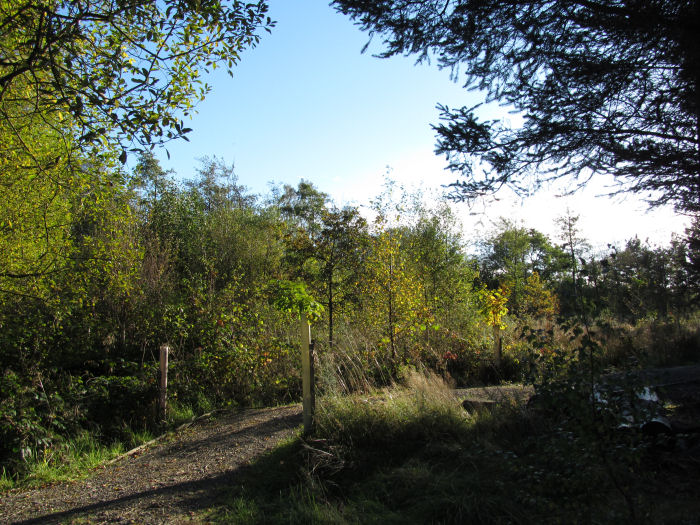
Toad in the Hole
Thursday, October 11th 2012
This morning was spent building a hibernaculum at the outdoor classroom. Hibernacula are habitats designed to give ideal conditions for hibernating animals over the winter months. There is high variation in the temperature of the soil over the course of day and night, dependant on weather and air temperature. Our hibernaculum is dug down into the earth, to provide an environment with stable, frost-free temperatures and protection from predators.
Here is our step-by-step guide to building your own - for amphibians it will need to be south facing and no further than 200m from a pond or stream.
Step 1
Dig a hole 3ft across and just over 2ft deep (make sure there are no water pipes or cables in the area you plan to use!). Pile the soil and grass nearby ready to cover the structure when finished.
Step 2
Add 4-6 inches of gravel to the bottom of the hole to aid drainage.
Step 3
Rocks, plant pots and logs can be used to create chambers. Almost anything can be considered as long as it is not too tightly packed and the gaps between are not too large. The idea is to create small chambers that will remain moist and at a constant temperature. If the gaps are big the temperature will fluctuate too much; if the chambers are tightly packed the animals won't be able to find their way in.
Step 4
The top and any large gaps should be loosely packed with twigs, branches and leaf mould which will act as insulation.
Step 5
Logs should be piled over the top to prevent the soil washing down into the cavities. At this point an old drain pipe can be installed as the entrance to the hibernaculum.
Step 6
Cover over with soil and don't be too concerned if a few logs are sticking out when you have finished!
Replace the grass and make sure the entrance is still clear!
Finally, sit back and wait for the hibernating animals to come flocking in. We hope newts, frogs, toads, lizards, mice and voles will use ours! Below is the finished hibernaculum near to the bug hotel at the outdoor classroom.
First Frost
Wednesday, October 10th 2012
The reserve was covered in the first thick frost of the winter as we drove in. The heathland was looking fantastic, glistening in the early morning sun.
The Dexters were hungry after such a cold night and were easily rounded up into the corall ready to be fed and collected.
The farmer quickly came over and they were loaded into his trailer, ready to start their journey back to Big Sheep Little Cow in Bedale.
Dams and Beavers
Tuesday, October 9th 2012
Thirteen volunteers enjoyed the sunshine up on the moor this morning. Work continued weeding out the ancient hedgelines to give the saplings the best chance of surviving. The young trees are doing very well and in about 5 years time the hedge will be layed.
Barrows full of grass were taken away.
Young Gorse was cut with brushcutters and raked up to improve an area of this habitat for wildflowers.
Pupils from the Dales School helped out with both of these tasks too. After lunch attention turned to the washed out dams in Risedale beck. These dams provide feeder pools for important ponds and are good fun to re-build.
The Foxglove volunteers will sleep well tonight!
Volunteers also helped out with weighing out bird seed to sell, administration tasks and trying to catch the Dexter cattle (who once again avoided the corral)! Leyburn Beaver Group visited the reserve and went on a nature walk this evening. They enjoyed playing in the metal dams at the outdoor classroom. Thank you everyone for your continued support.
Dexters Away! (Almost)
Monday, October 8th 2012
The farmers from Big Sheep Little Cow came this afternoon to collect their Dexter Cattle from the wetland. A corral was quickly built to help funnel them into the trailer.
The farmer then tempted them over with the promise of some food.
They followed obediently until they spotted the trailer and promptly ran off to the other end of the wetland. The next 45 minutes or so were spent trying to herd them back over to the area near the hide. The wetland resembles a maze and the cattle seem to know it well enough to slip past us in the opposite direction whenever we got near.
The Dexters are still enjoying the wetland; with a feeding pen now built, it should hopefully be easier to catch them later in the week!
First Worky Day
Sunday, October 7th 2012
What a glorious day! Sun and warm and dry! The task was the removal of the hedge on the heath. This is the 'before' photograph that we like to take and keep for the records.
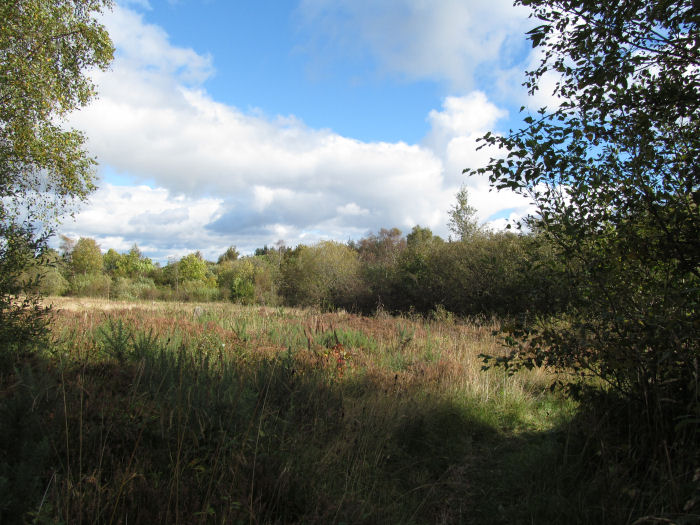
On Friday, Sophie and Adam felled the trees in readiness for Saturday morning..
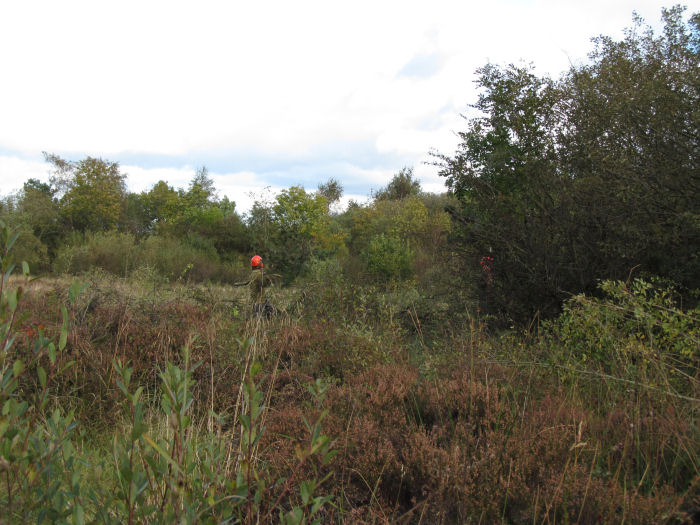
The fire was started and soon brash was being cut ready to be burnt.
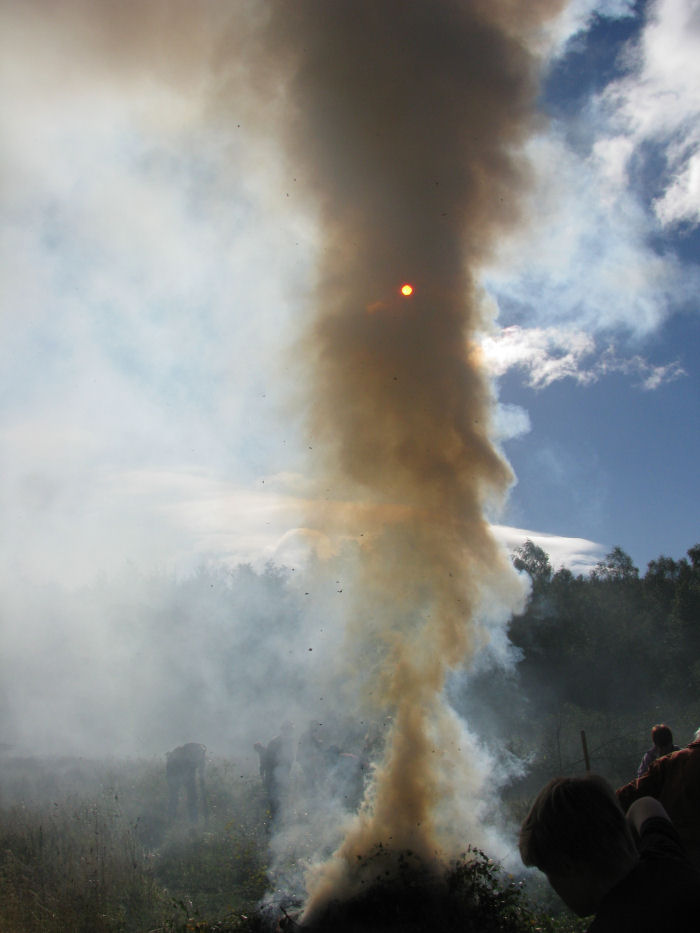
Everyone was busy.
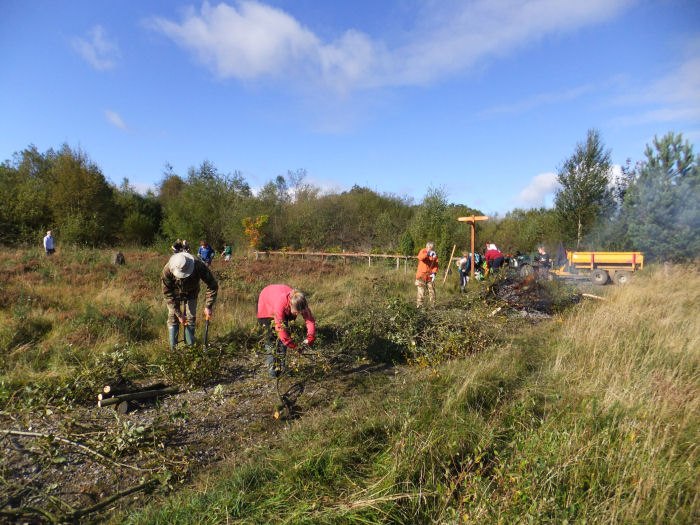
This photograph was taken from a high vantage point , the back of the trailer! You can see that over half of the hedgeline has been cleared. And what a difference it has made.
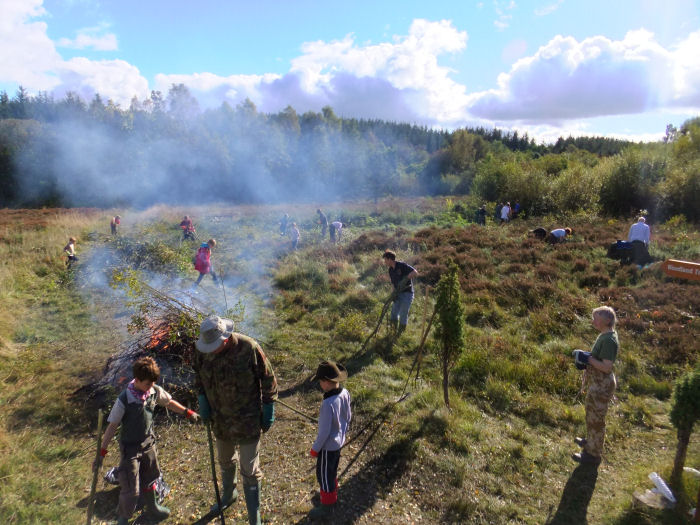
By the end of the day the heath was open. This is the 'after' photograph, as we left this evening.
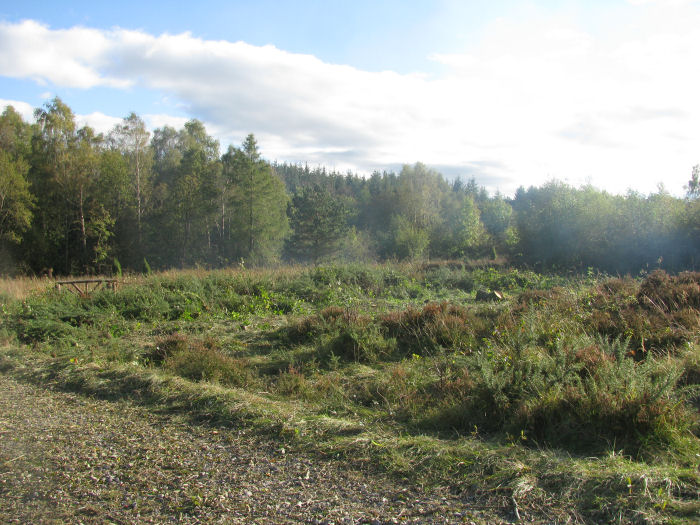
Before we all returned to the porta-cabin for tea and cakes a group photograph was lined up. Adam set the timer on the camera and sprinted through the heather to be included in the photograph.
.jpg)
A big thank you to everyone who helped today.
Inspired by Wildlife
Friday, October 5th 2012
GCSE art students from St Francis Xavier School in Richmond made use of the indoor classroom today to practice their drawing skills.
The taxidermy provided a great way to study the form of some of our native wildlife from close quarters. The owls were a popular choice for the artists.
You can see some of the artwork in the following photos.
Moor than just a Nature Reserve!
Wednesday, October 3rd 2012
There are two ancient hedgelines on the moorland that have been re-planted as part of the HLS (Higher Level Stewardship scheme). The idea is that these will act as corridors for wildlife between the nature reserve and the wider army training area. Volunteers weeded out the native hedge yesterday to allow the young saplings to flourish as they were becoming choked with long grasses. Foxglove Covert is classed as an 'urban farm' under this agricultural scheme and the cattle and sheep are always of interest to visitors and especially local school children.
The Gorse bushes on the moorland provide welcome shelter even to the hardy Swaledale sheep when the weather is cold. There was definitely a wintery feel up the moor today!
The Dexter cattle are enjoying a pro-longed visit to the reserve as their fields back in Bedale were badly flooded last week.
There is a winter worky day on Saturday. In return for your hard work there will be a hot meal at lunch time and plenty of home baked cakes too. Please see the events section for further details. There is also a possibility of a visit to Donna Nook to experience the Grey Seal pupping in mid November. This would be for Friends and volunteers of Foxglove. If you are interested then please let Adam or Sophie know, there would be a charge to cover transport.
One Week On
Tuesday, October 2nd 2012
Volunteers were again hard at work putting right all the storm damage from last week's flood. Many people have volunteered their time since the floods hit the moorland, red route and Risedale Beck; thanks to their hard work all the paths around the reserve are now repaired!
Other jobs that were completed at Foxglove today were rebuilding dams on the voley ponds, and weeding out the ancient hedge lines on the moorland - thank you to everyone for lending a hand!
Fungi is appearing all over the site; conditions this autumn are perfect! Conifer Mazegill is a dark-brown, thin, fan-shaped bracket often found clustered on dead wood of conifers and occasionally on broadleaf trees, and causes an intensive brown rot. It is the maze-like arrangement of pores on the underside of the bracket that gives this fungus its name.
A Little Update
Monday, October 1st 2012
The reserve has almost recovered from the flood last week, Risedale Beck is now flowing at its usual level allowing us to check the gabions and outflow from the reserve. You can see from the fence how high the water level reached - a good 6 feet above the normal height.
The cows on the wetland are doing their job well, and have really kept on top of the grass and rush growth on the bunds. We expect these will be leaving Foxglove soon, but hope that a few will be back in the spring to help manage this habitat again.

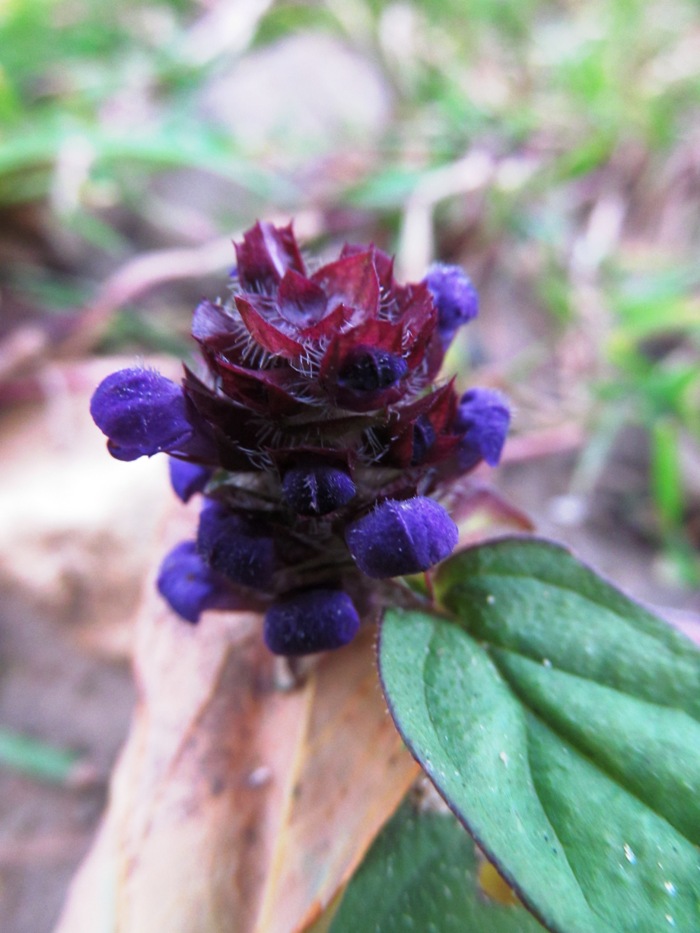





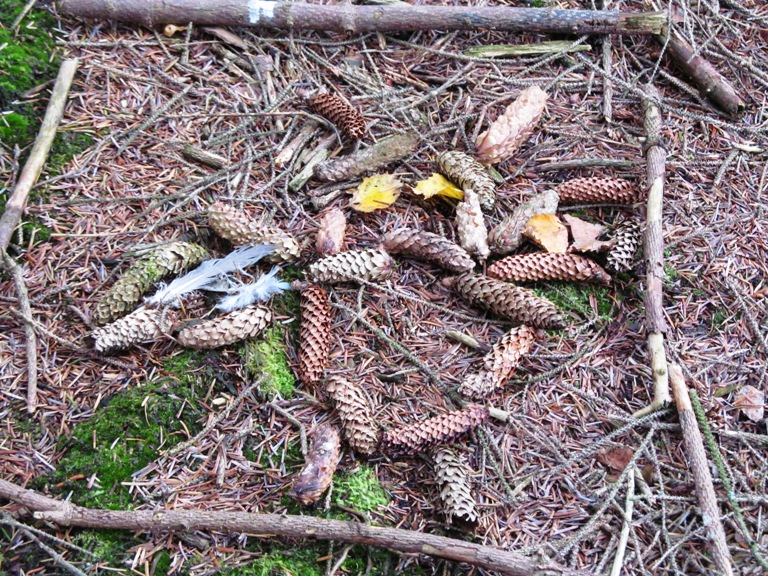

.JPG)
.JPG)
.JPG)
.JPG)
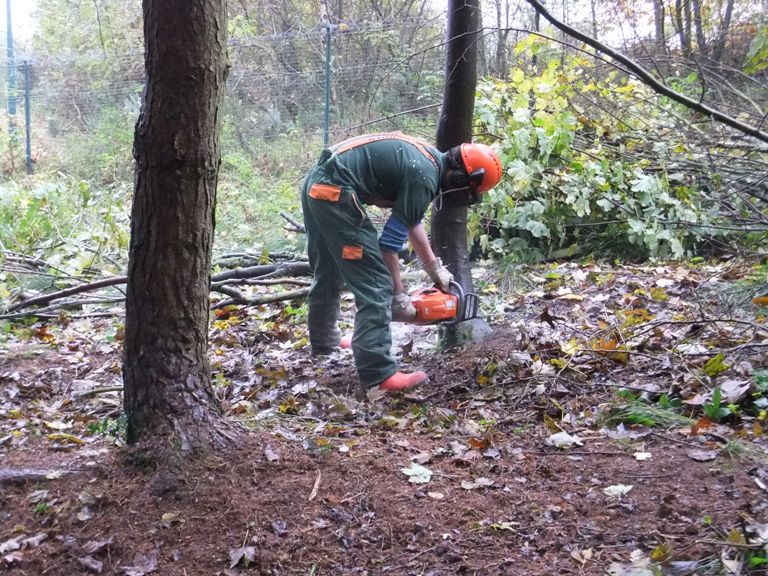
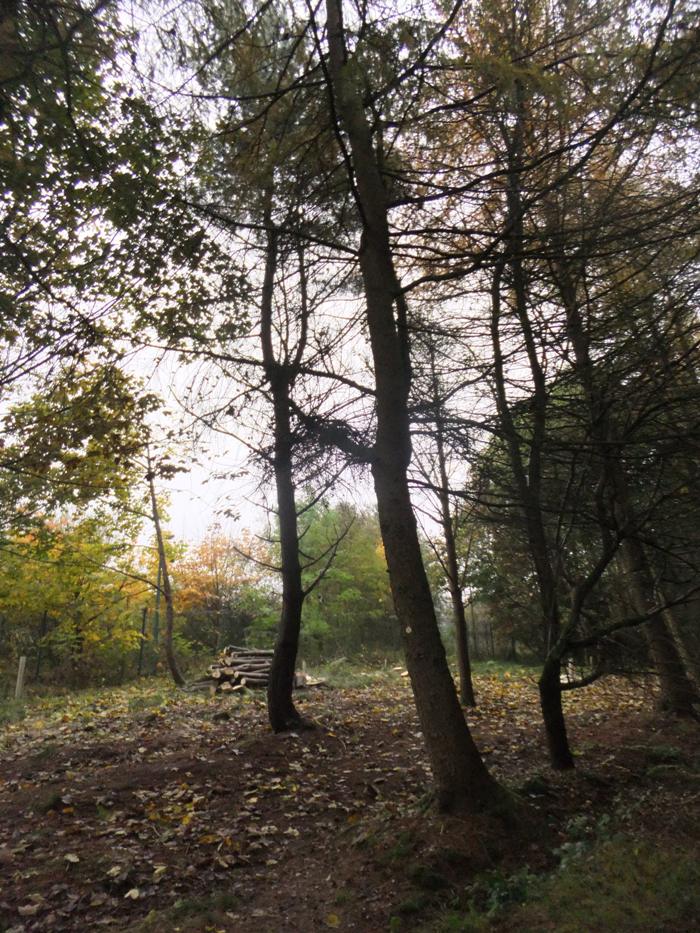
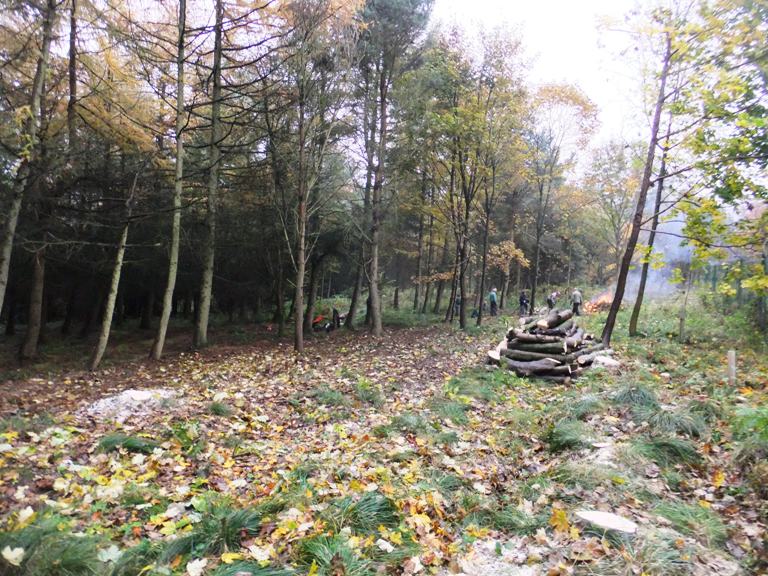



.JPG)












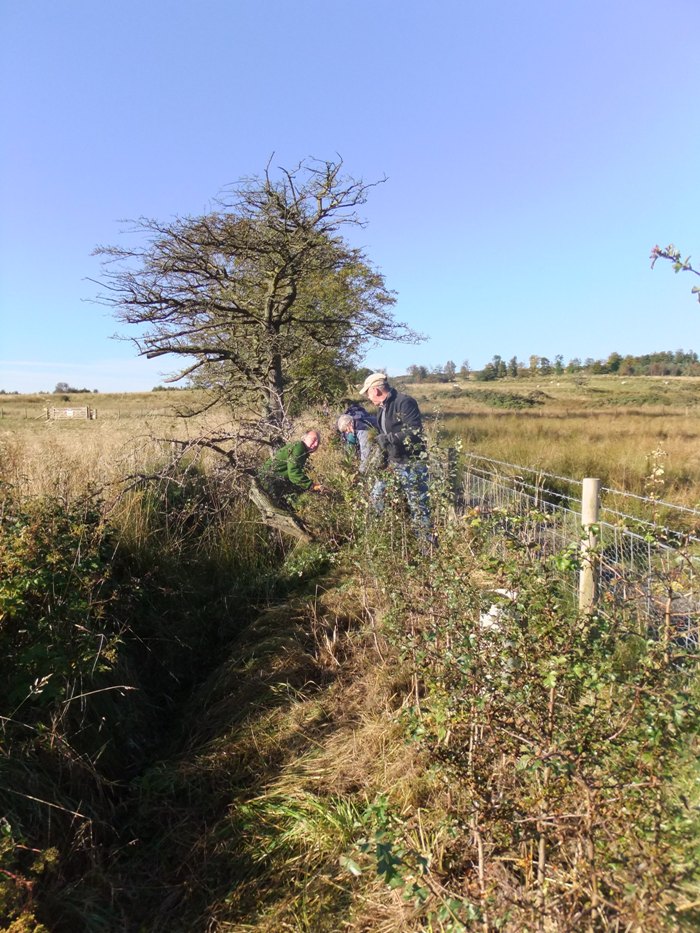
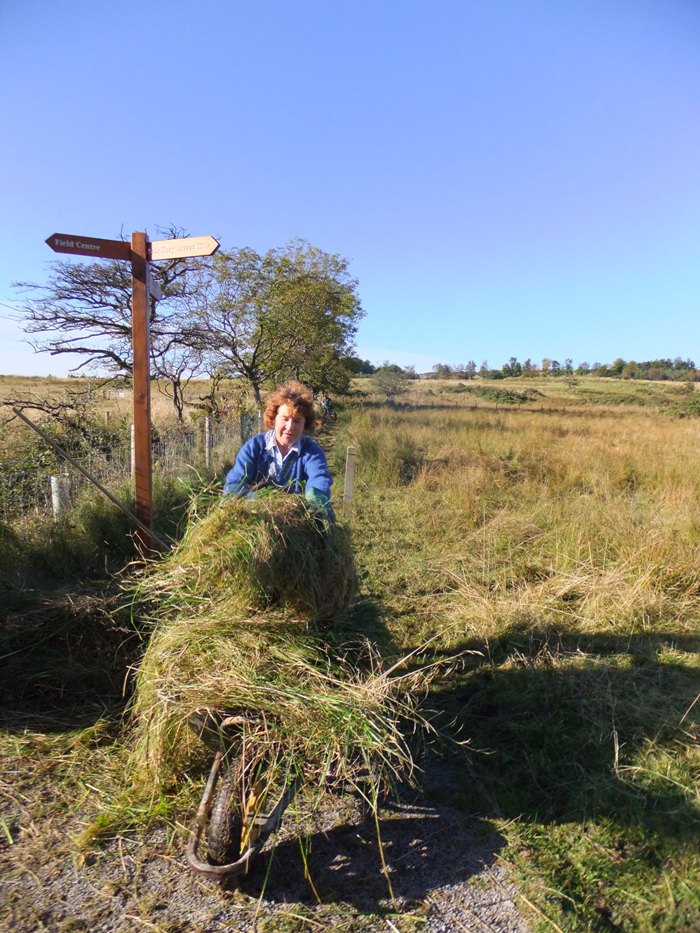
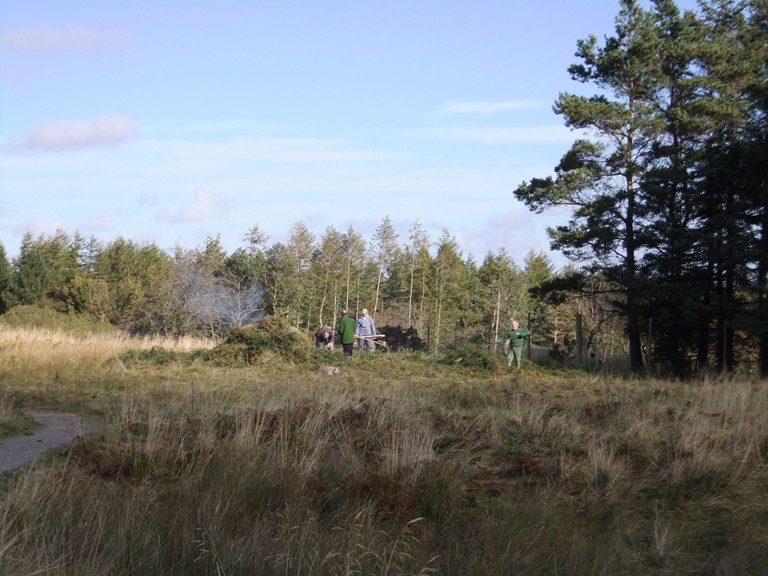
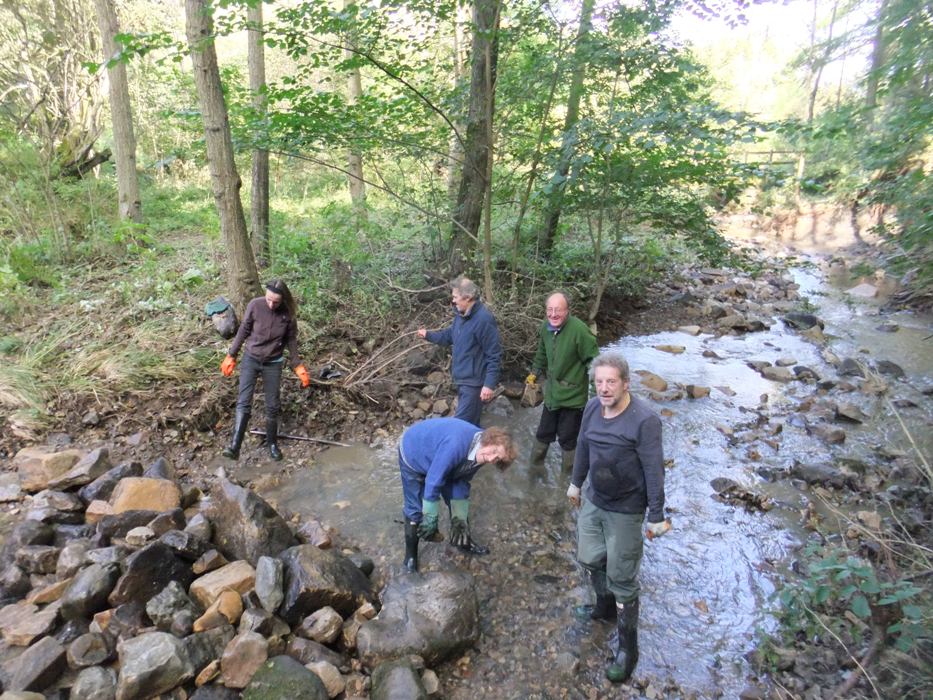
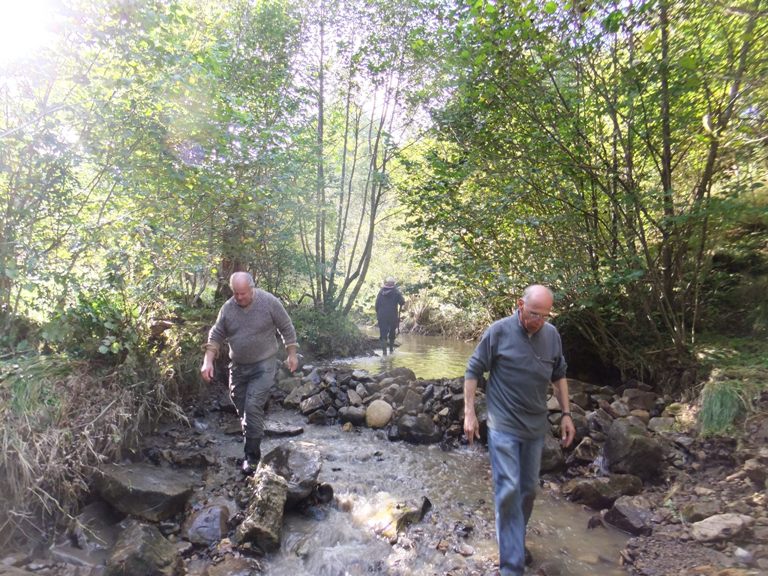
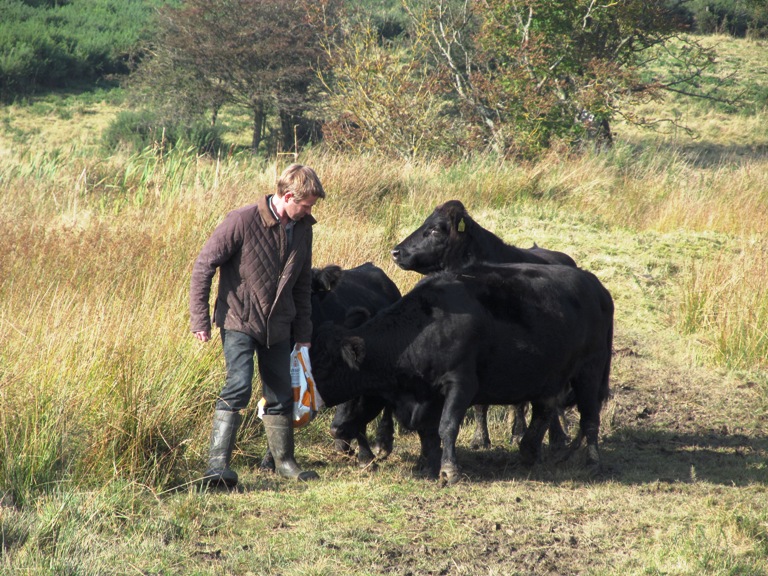


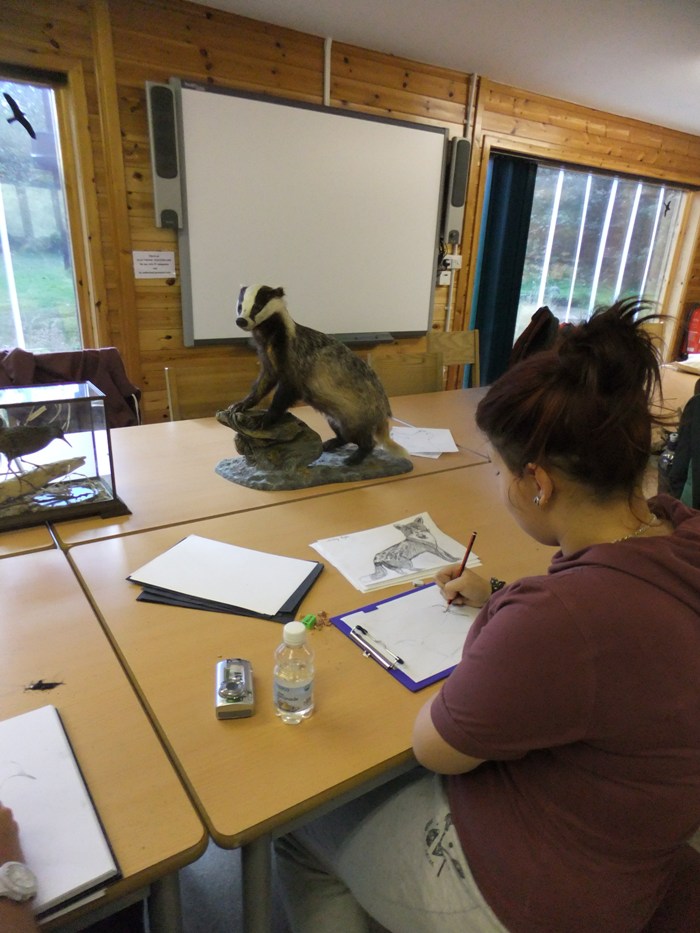
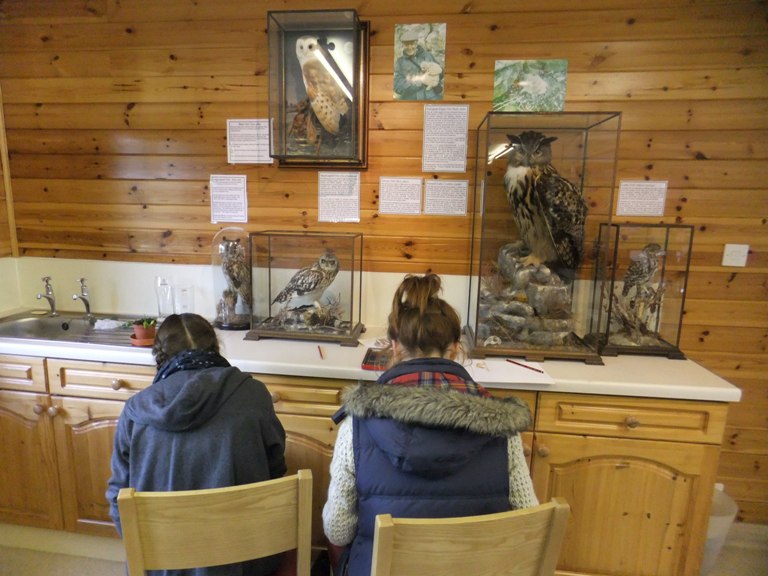
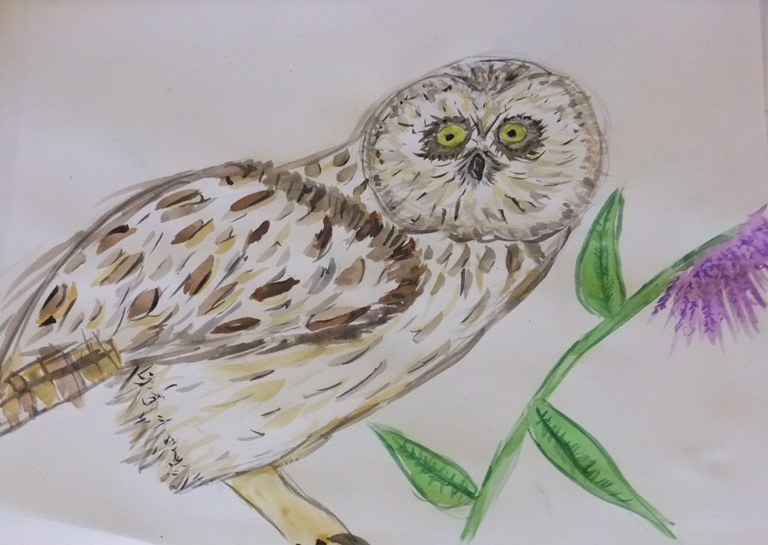
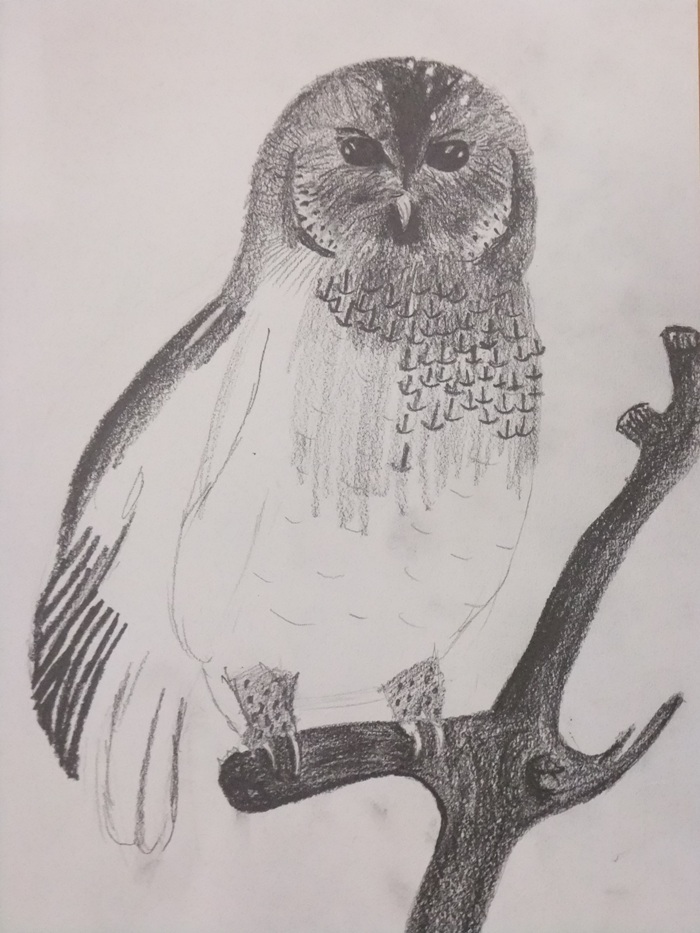
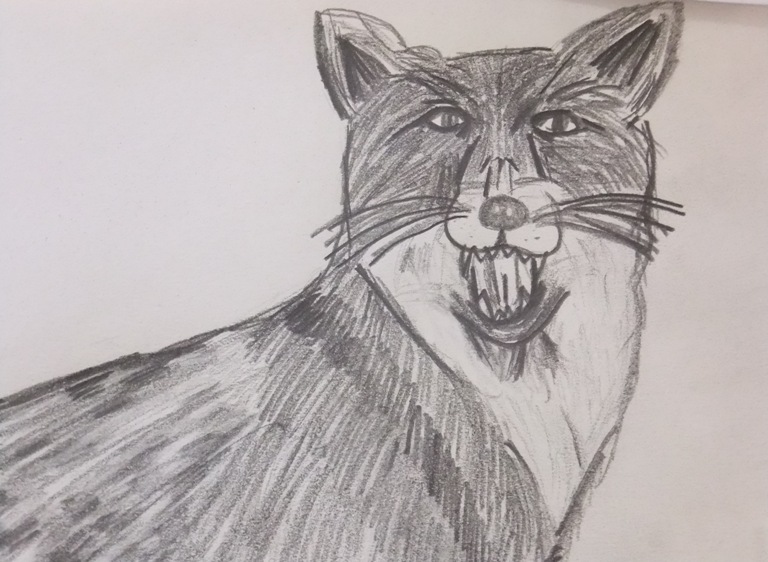
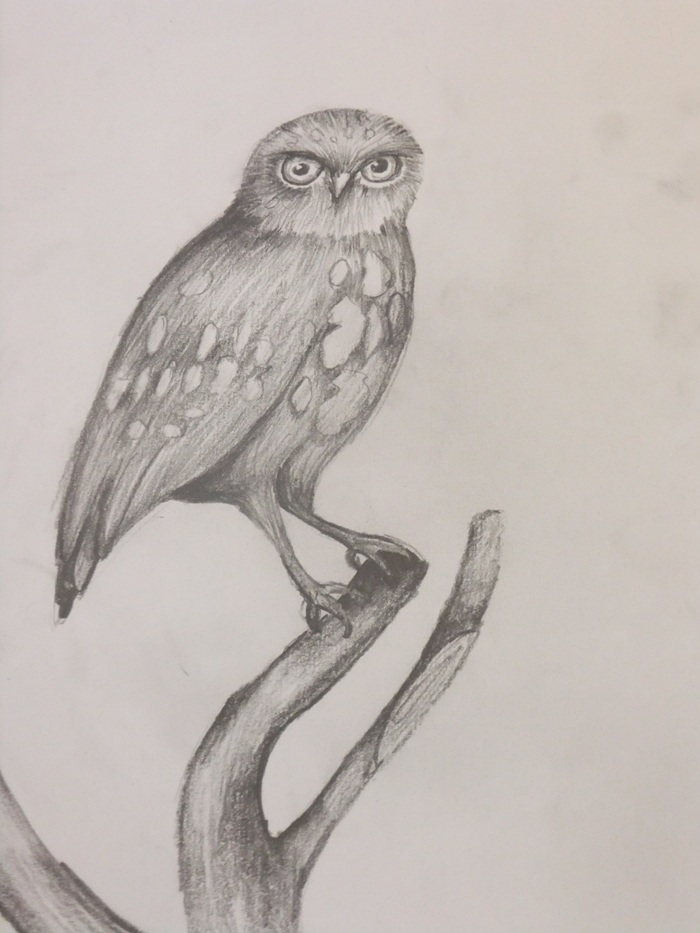
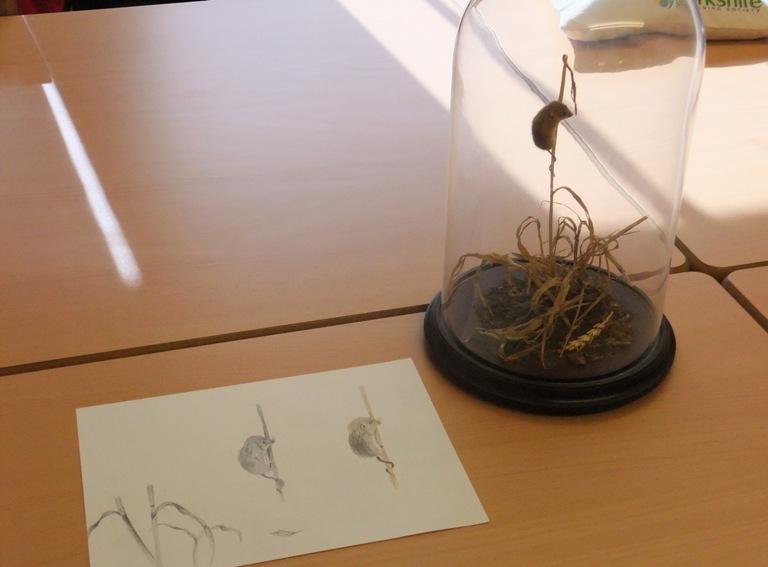
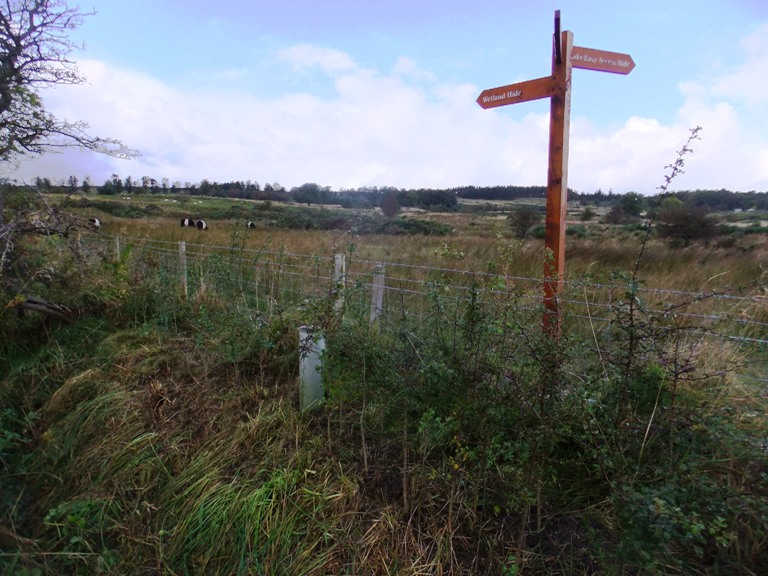
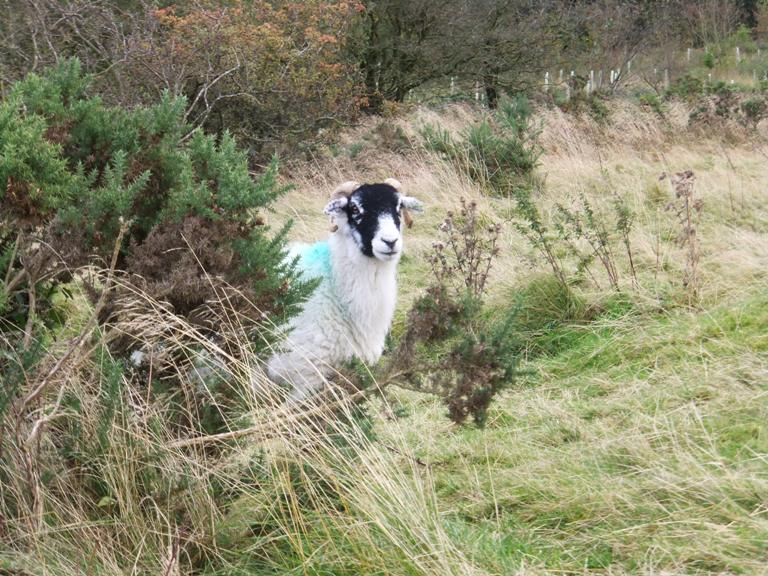
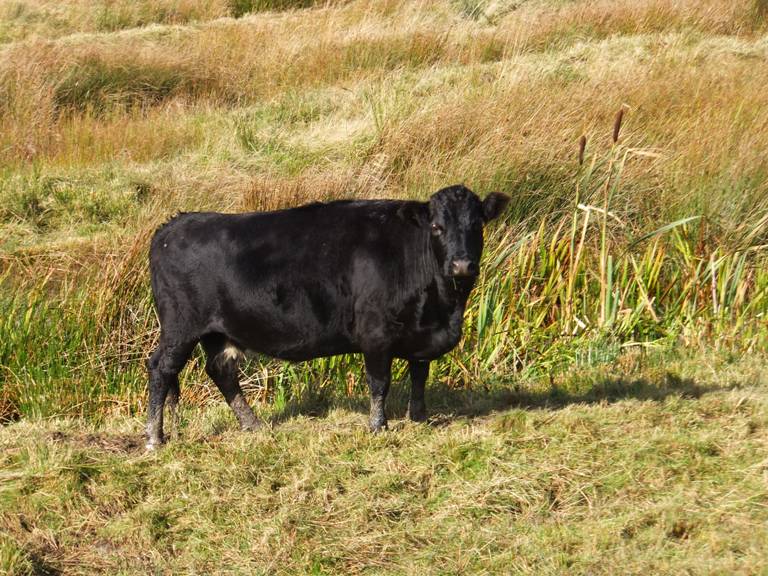

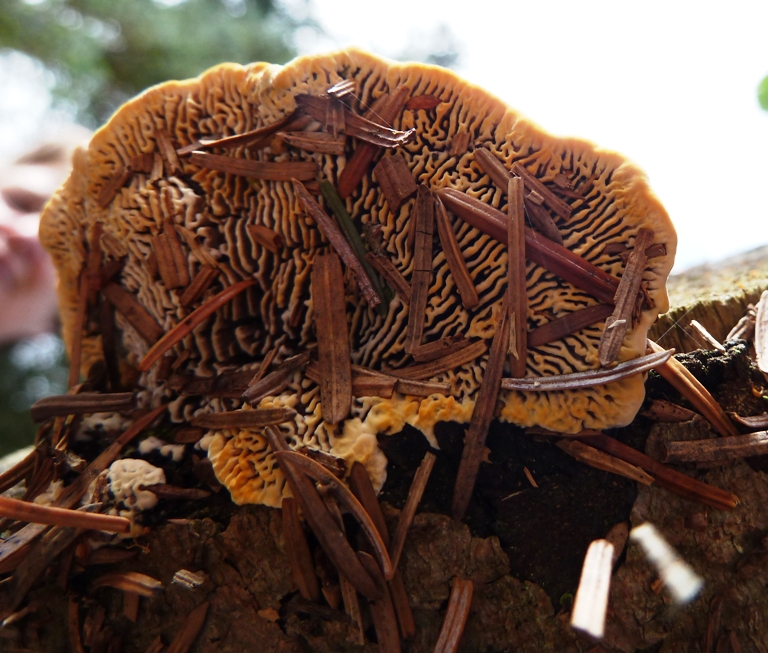
.JPG)

